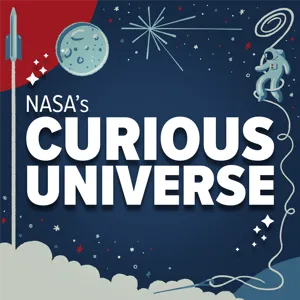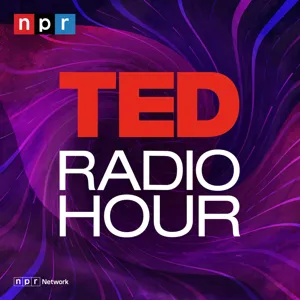Podcast Summary
Total Solar Eclipse of April 8, 2023: A Scientific and Emotional Experience: The Total Solar Eclipse of April 8, 2023, was a unique scientific opportunity for researchers and an emotional experience for millions, inspiring awe and connection.
The total solar eclipse of April 8, 2023, was a significant event that drew the attention of millions, both through NASA's live broadcast and in-person experiences. NASA's Curious Universe team covered the event extensively, reporting from various locations along the path of totality. Christian Elliott, a producer for the show, shared his personal experience of traveling to Kerrville, Texas, to capture the lead-up to the eclipse. He met festival-goers and scientists, some of whom had planned for years to witness the event. For scientists like Ben Beau, a solar physicist, the eclipse was a rare opportunity to study the sun's atmosphere and corona. The event underscored the awe and excitement that a total solar eclipse can bring to people, inspiring both scientific exploration and emotional connection.
Mitigating weather risks for solar observations: Teams plan backup locations, use kite missions, and chase eclipses to ensure clear skies for solar observations, maximizing scientific discovery and awe.
During a solar observation event, having clear skies is crucial for obtaining accurate data, but unpredictable weather can pose a significant challenge. Ben's team, set up in Texas, was hoping for clear skies to study the sun's corona, but faced the possibility of clouds. To mitigate this risk, they had backup plans, including having teams in Mexico and Arkansas and a kite mission flying high above the clouds with instruments. The kite mission, modeled after Benjamin Franklin's experiment, aimed to capture data from over a mile up, with NASA's research planes flying even higher. With only one opportunity every 18 months or so to observe solar phenomena, the team leaves nothing to chance and chases eclipses for both scientific discovery and personal awe.
The emotional impact of scientific events: Scientific events can evoke strong emotions and leave a lasting impact on those involved, inspiring curiosity, determination, and a sense of awe.
The experience of witnessing a scientific event, such as an eclipse or discovering a comet, can be deeply emotional and transformative. For those involved, it moves beyond being just an abstract concept taught in a classroom. It becomes a powerful, personal moment that can leave a lasting impact. As shared in the conversation, the anticipation and nerves leading up to the eclipse were palpable for some team members. The importance of the moment was not lost on them, and the potential outcome kept them focused and determined. Similarly, Alan Hale's discovery of Comet Hale-Bopp was a pivotal moment in his life. The unpredictability of comets made his discovery even more remarkable, and the subsequent attention and recognition he received launched his career. The emotional connection to these scientific events serves as a reminder of the human side of science. It highlights the excitement, curiosity, and passion that drives individuals to explore the world around them and make new discoveries. Ultimately, these moments can change lives and leave a lasting impact on those who witness them.
Solar Eclipse of 2022: A Time for Scientific Discovery: Dedicated scientists and comet hunters made the most of the 2022 solar eclipse to observe sungrazing comets from the ground, while teams used the opportunity to calibrate space observations.
While the solar eclipse of 2022 captured the attention of millions, it was also a significant time for scientific discovery. Alan, a dedicated comet hunter, made a last-ditch effort to spot a sungrazing comet from the ground during the eclipse. This was a challenging task as sungrazers are bright and close to the sun only during totality, and they disintegrate shortly after. Alan, who had been trying since the 70s, saw this as his last best chance due to his advancing age and the long wait for the next eclipse in the US. Meanwhile, scientists like Carl Badhams and their teams were using the eclipse as an opportunity to make ground observations of sungrazers to calibrate SOHO's detections from space. With the help of orbital experts, they were trying to spot these elusive comets from the ground. On the day of the eclipse, unexpected weather conditions forced Christian to make a last-minute change in plans, joining the NASA broadcast team in Dallas instead of his original location in Kerrville. Hundreds of scientists and communications staff were spread across the country, contributing to the collective effort to study the eclipse from various sunspots. These stories illustrate the dedication and excitement of individuals and teams in the scientific community who continue to explore and learn from natural phenomena like solar eclipses.
Communities across the country come together for the solar eclipse: The 2017 solar eclipse brought people together, creating a festive atmosphere with food, music, and educational presentations from NASA and NOAA.
The total solar eclipse of 2017 brought people together in various communities across the path of totality, creating a festive and exciting atmosphere. From Paris, Arkansas to Carbondale, Illinois, and even the Indianapolis Motor Speedway, people traveled great distances to witness this natural phenomenon. The events were filled with food, music, and educational presentations from NASA and NOAA. The spirit of the eclipse was contagious, with towns and cities commemorating the event with flags and decorations. The enthusiasm and anticipation were palpable as the day drew closer to totality, making it a memorable experience for all involved.
Community comes together for solar eclipse: The solar eclipse brought people together, inspiring excitement and curiosity, despite uncertainty of weather, with noticeable temperature changes and animal behavior effects reported.
The solar eclipse brought people from various backgrounds and ages together, sharing their excitement and anticipation for this natural phenomenon. Many had prepared for months or even years, knowing the changes it would bring, such as temperature drops and animal behavior. Children, especially, were eager to learn and experience the eclipse, some even dressing up as astronauts. Despite the uncertainty of the weather, the sense of community and shared curiosity remained strong. NASA reported that the eclipse would cause noticeable temperature changes and affect animal behavior, adding to the excitement and intrigue. Overall, the solar eclipse served as a reminder of the awe-inspiring power of nature and the unique connections it can create among people.
A stunning display of darkness and colorful skies during the 2017 total solar eclipse: Millions witnessed the eclipse's noticeable changes: clear skies, temperature drop, blue sky, red-orange horizon, and active animals.
The total solar eclipse of 2017 was a breathtaking and awe-inspiring experience for millions of people across the world. Despite initial concerns about cloud cover, the skies cleared just in time for totality, revealing a stunning display of darkness, cooler temperatures, and colorful skies. The atmosphere was filled with excitement and anticipation, as people gathered together to witness this natural phenomenon. The temperature drop, the steely blue sky, and the red-orange horizon were just a few of the noticeable changes during the eclipse. Animals also seemed to be affected, with some species becoming more active before the event. The moment of totality, when the moon fully eclipsed the sun, was described as surreal and incredible by those who witnessed it. Overall, the total solar eclipse of 2017 was a reminder of the beauty and power of nature and the importance of taking the time to appreciate it.
Experience the awe-inspiring sight of a total solar eclipse: Witnessing a solar eclipse leaves a lasting impression and provides valuable scientific data
Experiencing a solar eclipse in person is a truly awe-inspiring and spiritual event that leaves a lasting impression. The corona, the outer layer of the sun that is usually not visible, becomes visible during a total solar eclipse, transforming the day into night. Witnessing this phenomenon firsthand was described as an almost otherworldly experience by those who were fortunate enough to see it. The excitement and energy surrounding the event were palpable, with many expressing their joy and amazement at the sight. Despite the event only lasting for a short period of time, it left a profound impact on those who witnessed it. The disappointment was shared by those who were unable to see the eclipse due to cloud cover, highlighting the importance of good weather conditions for this natural wonder. The data collected during the eclipse by scientists and citizen scientists will provide valuable insights into the sun, and the anticipation for the next solar eclipse is already building.
Solar Eclipse Brings People Together Through Data Collection and Collaboration: During the solar eclipse, various projects collected an enormous amount of data from citizens, fostering a sense of camaraderie and showcasing the power of collaboration in exploring the universe.
During the recent solar eclipse, various projects collected an unprecedented amount of data from citizens around the country. The SunSketcher project gathered 32,000 cell phone photos of Bailey's beads to help scientists calculate the sun's size and shape more accurately. Additionally, the Eclipse Soundscapes team received over 700 audio recordings from citizen scientists using moth devices and received 7,000 observations. This unified experience brought millions of people together, looking up at the sky during this cosmic event. The sense of camaraderie was palpable, even among strangers. NASA's Curious Universe team expressed their joy of witnessing the eclipse and producing the sun series, emphasizing that the sun isn't going anywhere, and neither are we. The team is grateful for listeners' support and promises to continue sharing stories from NASA and the universe. Overall, the solar eclipse brought people together in a unique way, showcasing the power of collaboration and the awe-inspiring beauty of our universe.






